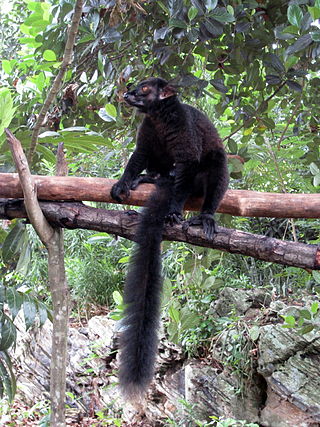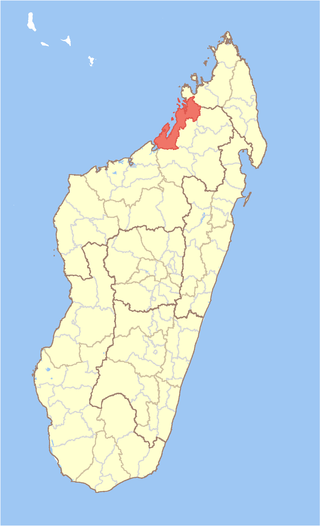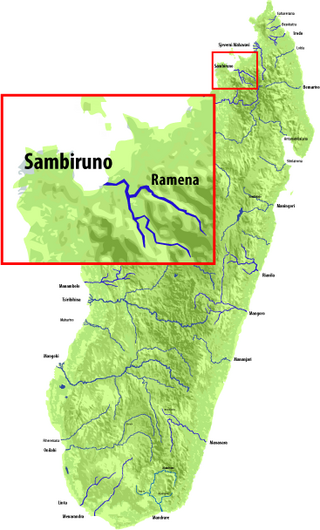
Antsiranana is a former province of Madagascar with an area of 43,406 km2. It had a population of 1,188,425. Its capital was Antsiranana. A diversity of ethnic groups are found in the province, including Anjoaty, Sakalava, Antakarana, Tsimihety, Antemoro, Betsimisaraka, Antandroy, etc.

Sofia is a region in northern Madagascar. It is named for the Sofia River. The region covers 50,100 km² and had a population of 1,500,227 in 2018. The administrative capital is Antsohihy.

The giant mouse lemurs are members of the strepsirrhine primate genus Mirza. Two species have been formally described; the northern giant mouse lemur and Coquerel's giant mouse lemur. Like all other lemurs, they are native to Madagascar, where they are found in the western dry deciduous forests and further to the north in the Sambirano Valley and Sahamalaza Peninsula. First described in 1867 as a single species, they were grouped with mouse lemurs and dwarf lemurs. In 1870, British zoologist John Edward Gray assigned them to their own genus, Mirza. The classification was not widely accepted until the 1990s, which followed the revival of the genus by American paleoanthropologist Ian Tattersall in 1982. In 2005, the northern population was declared a new species, and in 2010, the World Wide Fund for Nature announced that a southwestern population might also be a new species.

The northern giant mouse lemur, or northern dwarf lemur, is a species of lemur discovered in 2005. They are part of the primate order, and classified in the family Cheirogaleidae. Previously, both populations of giant mouse lemurs were believed to belong to one species. The northern giant mouse lemurs are small nocturnal lemurs endemic to Madagascar. They weigh about 300 grams (11 oz), and have long, bushy tails and relatively small ears. Their large testicles are an indication of their promiscuous copulation system. These lemurs have been found to use communal sleeping nests including multiple males, which is an uncommon behaviour in lemurs.

The black lemur is a species of lemur from the family Lemuridae. Like all lemurs, it is endemic to Madagascar. Originally, the species was thought to have two subspecies, Eulemur macaco macaco and Eulemur macaco flavifrons, both of which were elevated to species status by Mittermeier et al. in 2008 to Eulemur macaco and Eulemur flavifrons respectively. The most startling difference between the two species is the eye colour; Eulemur flavifrons, the blue-eyed black lemur, has blue eyes, while Eulemur macaco, the black lemur, has brown or orange eyes, and also has ear tufts.
Analalava is a coastal town and commune in north-western Madagascar over the Mozambique Channel. It is approximately 150 kilometres north of Mahajanga and some 430 kilometres north of the capital Antananarivo. It belongs to the district of Analalava, which is a part of Sofia Region. The population of the commune was estimated to be approximately 10,000 in 2001 commune census.
Andasibe-Mantadia National Park is a 155 square kilometre protected area, located about 150 km east of Antananarivo, consisting principally of primary growth forest in Alaotra-Mangoro Region in eastern Madagascar. The park's elevation ranges from 800 to 1260 meters, with a humid climate. Average annual precipitation is 1700 mm, with rainfall on 210 days of each year. This rainforest is habitat to a vast species biodiversity, including many endemic rare species and endangered species, including 11 lemur species. The park's two component parts are Mantadia National Park and Analamazoatra Reserve, which is best known for its population of Madagascar's largest lemur, the indri.

Diana is a region in Madagascar at the northern part of the island. It borders the regions of Sava to the southeast and Sofia to the southwest. It covers an area of 19,266 km2, and had a population of 889,736 in 2018. The regional capital is Antsiranana.

Analalava is a district in northern Madagascar. It is a part of Sofia Region and borders the districts of Ambanja in northeast, Bealanana and Antsohihy in east and Boriziny (Port-Bergé) in south. The area is 4,380 km2 (1,691 sq mi) and the population was estimated to be 176,396 in 2020.

Bealanana is a district in northern Madagascar. It is a part of Sofia Region and borders the districts of Ambanja in north, Ambilobe in northeast, Andapa in east, Befandriana-Nord in south, Antsohihy in southwest and Analalava in west. The area is 6,543 km2 (2,526 sq mi) and the population was estimated to be 201,836 in 2020.

The western lesser bamboo lemur, also known as the northern bamboo lemur, western gentle lemur, or Sambirano lesser bamboo lemur, is a species of bamboo lemur endemic to Madagascar.
Bora Special Reserve is a wildlife reserve in the Sofia Region of Madagascar, between the villages of Antsohihy and Bealanana. Bora is in a transition zone between eastern humid forests and western dry forests and the reserve and has many endemic species including six lemur species, twenty birds and over 150 species of endemic plants.
Manongarivo Reserve is a wildlife reserve in the North-West of Madagascar in the region of Diana.
Marotandrano Special Reserve is a wildlife reserve in Mandritsara, Sofia Region, Madagascar. It is 10 km from Marotandrano and 42 km from Mandritsara.
Tampoketsa Analamaitso Reserve is a wildlife reserve of Madagascar located in the Sofia Region. It covers 17 150 ha in three districts: Port Bergé, Mandritsara and Mampikony.
Yves Rumpler, is a French researcher and primatologist. He was a professor of embryology and primatology at the Louis Pasteur University of Strasbourg until he retired in 2007.

The Sambirano is a river of northwestern Madagascar in the region of Diana. It has its sources at the Maromokotra peak and flows through the Tsaratanana Reserve to the Indian Ocean. Its delta occupies 250 km2.

Route nationale 6 (RN6) is a primary highway in Madagascar of 706 km, running from Antsiranana to Ambondromamy. It crosses the regions of Diana and Sofia. It was paved in 1992.
The Lavasoa dwarf lemur is a small, nocturnal strepsirrhine primate and a species of lemur that is endemic to three small, isolated patches of forest on the southern slopes of the Lavasoa Mountains in southern Madagascar. Fewer than 50 individuals are thought to exist. Its habitat lies in a transitional zone between three ecoregions: dry spiny bush, humid littoral forest, and humid forest. First collected in 2001 and thought to be a subpopulation of the furry-eared dwarf lemur (C. crossleyi), it was not formally described until 2013. It is one of six species of dwarf lemur, though the research that identified it also suggested the existence of many more new species.
The Sambirano region, also known as the Sambirano domain, is a biogeographic region of northwestern Madagascar. It has a distinctive lowland climate with year-round rain, differing from the rest of seasonally-dry western and northern Madagascar. The climate supports humid lowland rainforests, with greater similarity to those of eastern Madagascar than the dry deciduous forests characteristic of the Madagascar's western lowlands.












